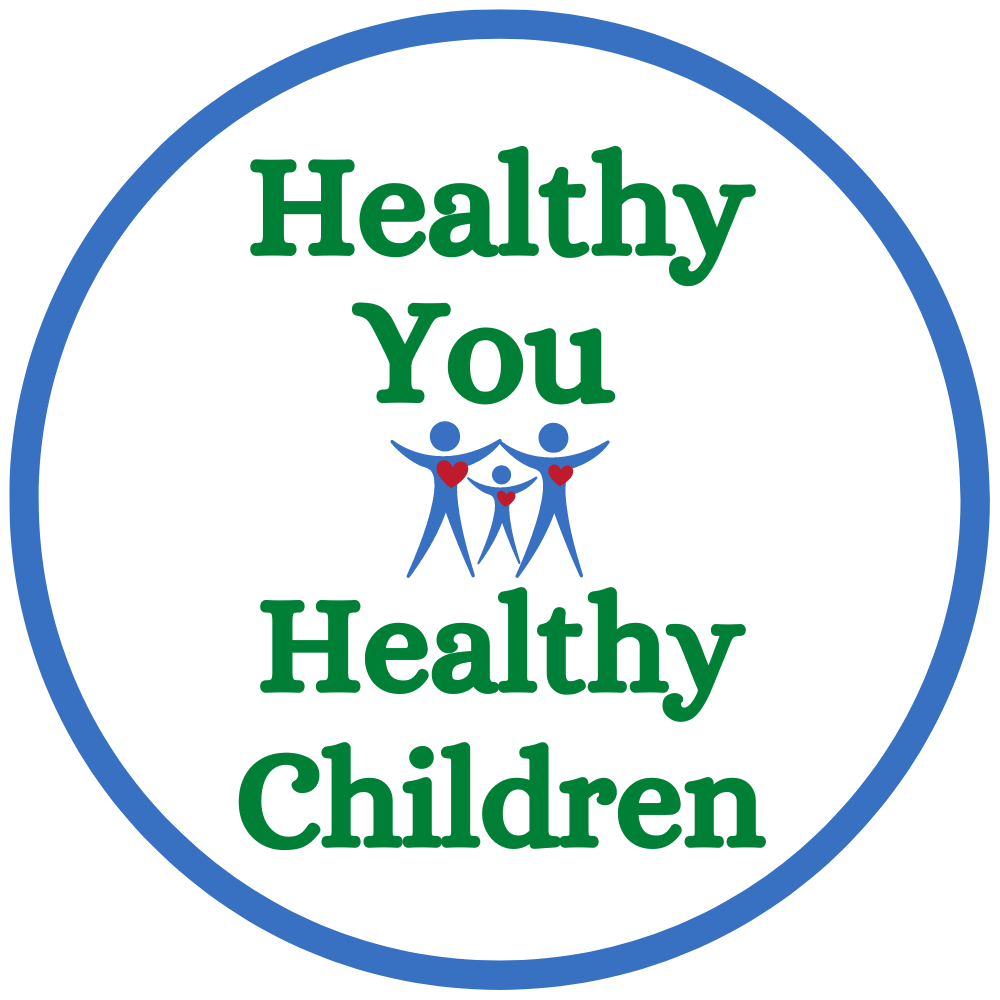In my article about the latest Physical Activity Guidelines for Americans, I mentioned the recommendations for physical activity in children of all ages and the many benefits of being active (click HERE to read it). Regular exercising promotes health and fitness at every age.
I am a mom of two very energetic boys. Even though they have gym class at school, relying only on this amount of physical activity per week is not enough. We try our best to keep them physically active in between school, homework, commuting, and other daily activities. Some days are better than others, but I can tell the difference when they have been moving during the day. They sleep better, they have a big appetite for healthy food, and their mood is cheerful and calm. Another golden rule at home: no screen time during the week! This has made a major impact on the quality and amount of free play for my kids.
If you are unsure how active your child is, an excellent way to start is by tracking for a week:
- How many hours does he spend watching TV?
- How often does he have gym class at school (if they have any)?
- How long are school breaks and what does your kid do during these times?
- How much time of free play and outdoor activities after school and on weekends?
The information about minutes spent on physical activity, screen time, homework, free play, and other activities will guide you on what changes to make. Children need to exercise every day for at least an hour.
Make it FUN! Ask your child what activities they prefer and try to add them to the family daily schedule to work for everyone. If your kid is not involved in the decision, he won’t feel motivated to do it. Exercise should become part of your kid and the family’s daily routine, like taking a bath, brushing your teeth, or sleeping.
Remember progression over perfection. Some physical activity is better than none. If your child is not active (mostly sedentary), he will need to start slowly and increase gradually, and a lot of family support. As I mentioned above – The Final Goal is to spend at least 1-hour being active per day.
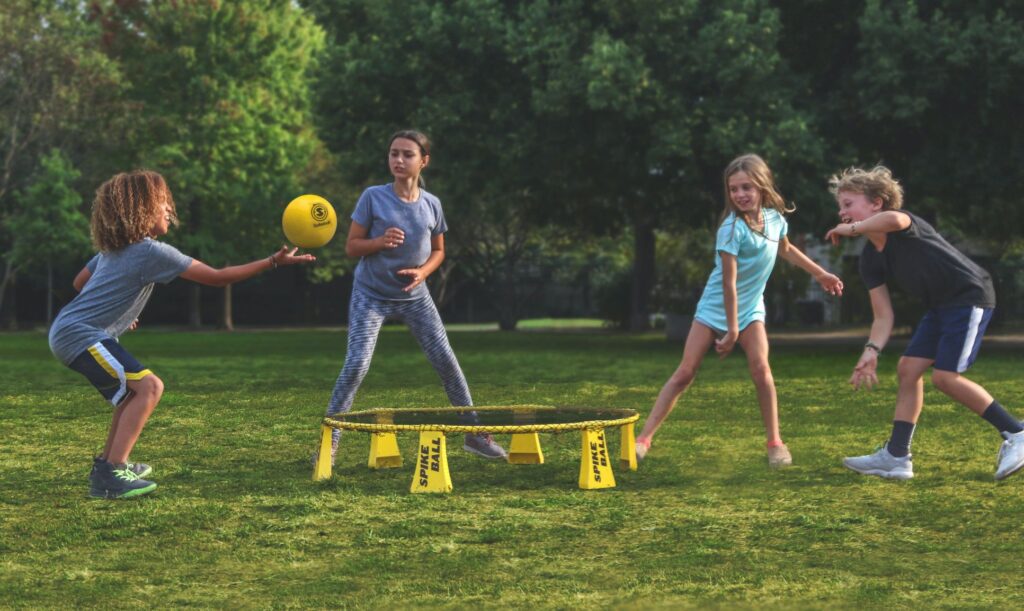
For pre-schooler kids (ages 3 to 5):
A lot of free play is critical at this age:
- hopping,
- skipping,
- jumping,
- climbing,
are great activities to strengthen bones and muscles.
Try to have toys available indoors and outdoor (if you have a backyard) for them to use. Taking them to a nearby playground is a great option.
Free play at this age also helps foster imagination, restore energy balance, and improves motor skills.
Structure play is also essential: some examples are
- throwing objects (a ball game),
- biking or tricycling,
- a walk with the family, and
- joining an activity program (swimming, dancing, gymnastic, etc.)
The screen time should be 2 hours or less (TV, tablets, phones, movies). Remember that kids of this age tend to be very active if they have the time.
According to the Guidelines of Physical Activities for Americans, 3 hours is “the average amount of activity observed among children of this age and is consistent with guidelines from Canada, the United Kingdom, and the Commonwealth of Australia.”
For school-age kids (ages 6-12):
During this period, after-school time seems to decrease every year. Get your child involved in adding physical activities to his daily schedule. You can plan together how to add certain activities that he likes and enjoy. The goal at this age is to turn exercise into a lifelong habit.
- Once again, a critical recommendation: Set screen time limits! It is crucial to start at a young age. Kids should not use TV, video games, tablets, phones after school for more than an hour during the week. Using more time on screens means less time on better activities.
- Free play and recreational activities should make up for most of the physical activity. They are fun and during these times, children use basic aerobic and bone-strengthening activities, such as running, skipping, jumping, and hopping, to develop movement patterns and skills. They also build muscle strength with activities that involve lifting or moving their body weight or working against resistance.
- For 6-10 years old kids who want to play organized sports, make sure these have limited rules, are short duration and allow some free play.
- For older children in organized sports (sports leagues, martial arts, minor leagues), the activity should be fun and build team skills and participation.
- If your kid prefers exercising without structure. Let him choose enjoyable activities and encourage him.
- Keep in mind household chores like cleaning the house, picking up toys, raking leaves, etc. These are physical activities as well!
- Organize family activities: take walks, play ball games, bike rides, sign up to take sports lessons together. Weekends can be a great time to exercise together and to try new activities.
- Consider different types of physical activities during the year, taking into account: seasons, weather, hours of daylight, and daily activities. This way, you will ensure that your kid remains active throughout the year.
- What if your child doesn’t want to exercise? Explain why it is important and encourage him to choose several new activities that sound fun (and fit in the family schedule and budget). Start with family activities to show him everyone is on board.
For Adolescents (age 12 to 17):
Unfortunately, many middle and high schools programs have very limited or no physical education programs. If you add the amount of homework and after-school activities, the opportunities to remain physically active are few.
At this age, it is very important to help your teen set goals and keep to them. Motivation and support are essential.
- As mentioned before, sit down with your child and organize his schedule to find time to be active every day, even if it is only for 15-20 minutes. If your kid is already exercising regularly, find ways to support this if his schedule gets busier.
- Free play, sports, or structured programs count toward meeting the key guidelines for physical activity.
- At this age, children can play organized games and sports and can sustain longer periods of activity. But any period of moderate- or vigorous-intensity activity, even a short one, counts toward the key guidelines.
- Adolescent girls tends to engage less in exercising comparing to boys, so they may need more support and encouragement to keep being active. Ask your girl to choose activities she likes or plan activities together.
- Adults’ tips to remain active count for teens as well: walk or ride to school instead of taking the bus (if safe and appropriate), take the stairs instead of the elevator, if driving to school: park far from the building, help with household chores, walk in place or around when on the phone.
- Remember the Screen Time Limit Rule! Having your teen moving around is better than having him lying on the sofa watching television all afternoon.
Examples of Physical Activities for Children:
I find the following table and the Kid’s Activity Pyramid useful for:
- Understanding how activities make a positive impact in your kid’s health and fitness.
- Having an idea of how to distribute the different physical activity levels during the day and the week
- Choosing activities that your kid may enjoy as well as family activities to be active together.
- You will notice on the table that some activities overlap between aerobic, muscle-strengthening, and bone straightening. Keep them in mind as a great option for your kid’s (and your family’s).
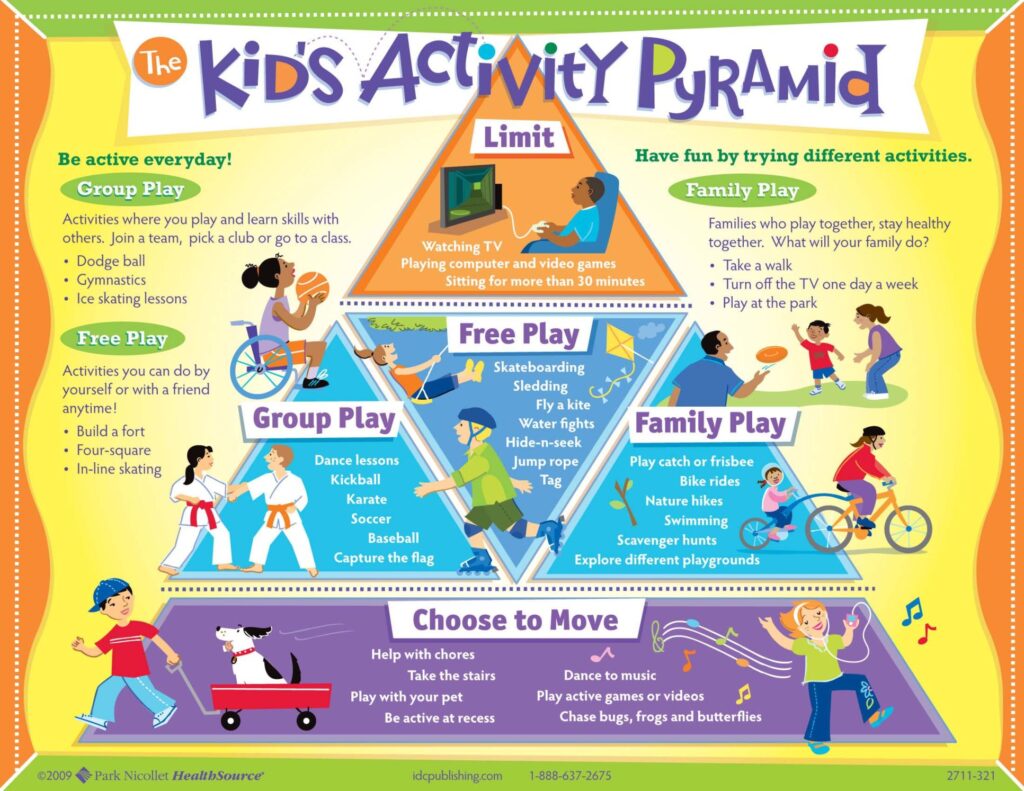
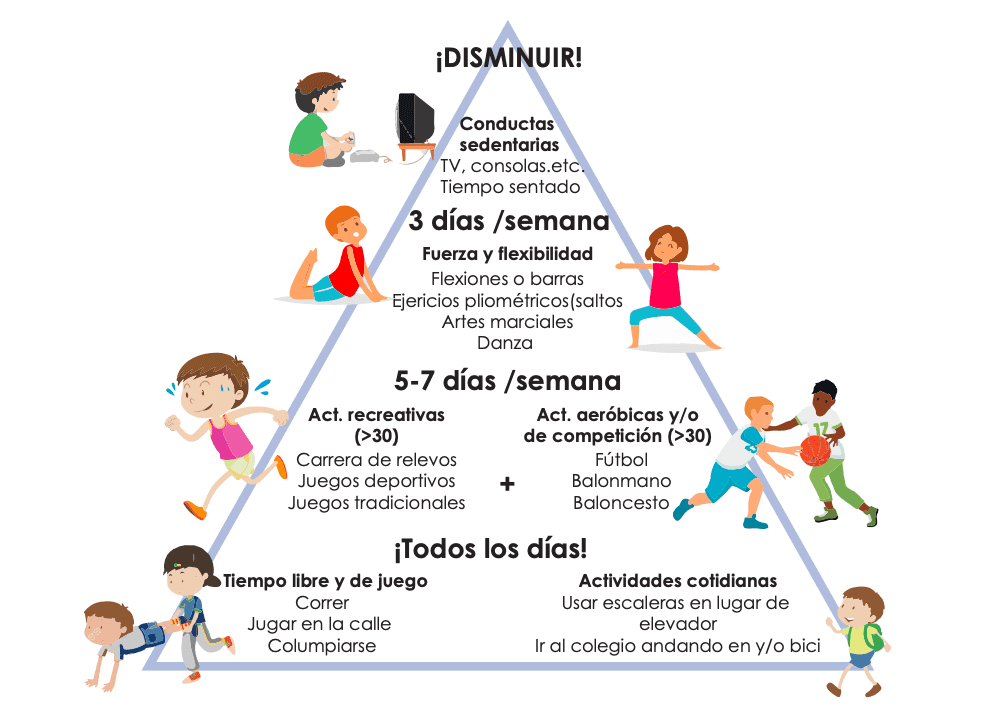


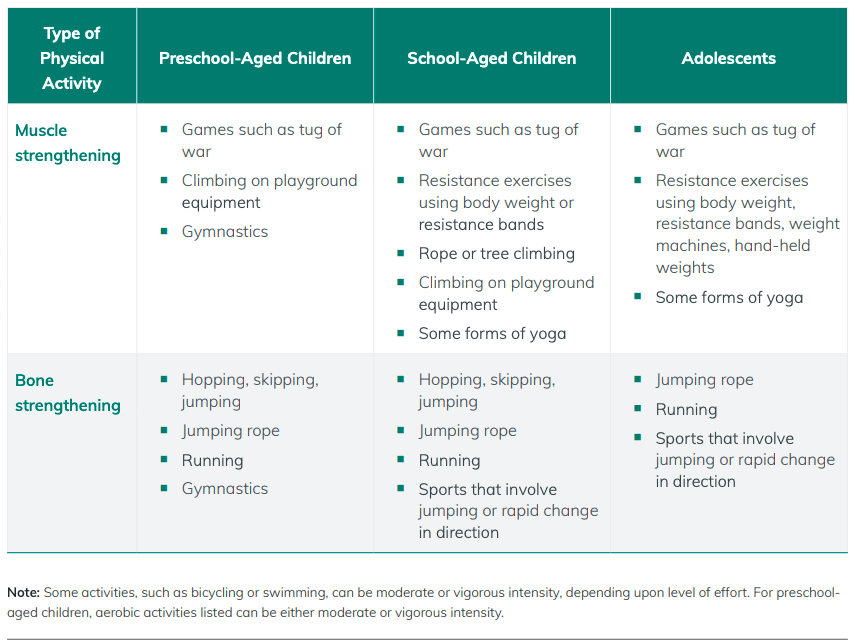
Final Thoughts:
Fitness is an essential part of health and wellness. Children need to be active to develop a healthy body and a healthy mind. The benefits of exercising are many. Unfortunately, most adults and children in the United States spend most of their time in Sedentary Activities. I cannot emphasize more the need of setting Screen Time Limits. Make exercising regularly and being active daily a lifelong habit for you and your children. As a busy parent, organizing your family’s schedule adding physical activity will make a big difference. Even 15-20 minutes will make a positive impact. You won’t regret it!
Read my article by clicking HERE if you would like to know more about the latest guidelines of physical activity, sedentary behavior, and the benefits of moving more and sitting less.
If you like my article, SUBSCRIBE TO MY BLOG to get news, updates, and more about a healthy lifestyle.
Check my WORK WITH ME section to learn more about my Health Coaching Program if you struggle with making lifestyle changes to improve weight, energy, and mental focus. I can help you and your family. BOOK A CALL with me if you are ready to move on.
